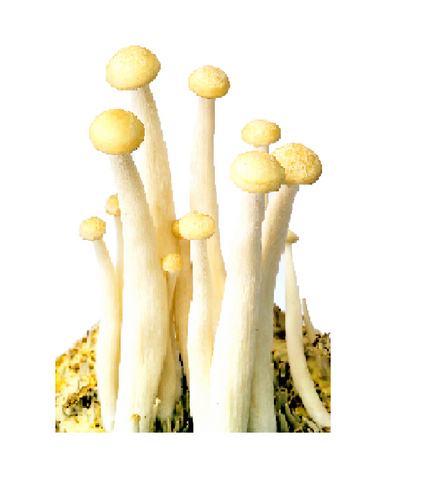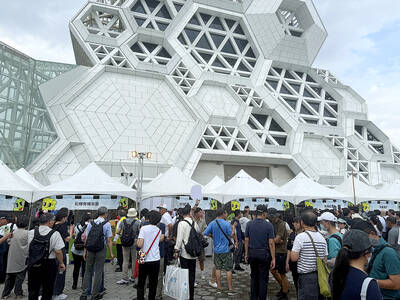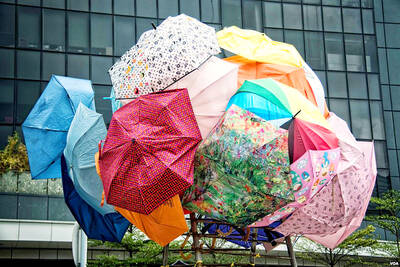You can pluck as many mushrooms as you like in Puli nowadays. Traditional mushroom-growing farms there are turning themselves into recreational theme parks, with the emphasis on do-it-yourself, from picking them by hand to cooking them in microwave ovens.
To double your fun, Rich Year Farm offers classes to group visitors on how to prepare "outer-space bags" -- small packs of earth and nutrients that you can take home and use to grow your own mushrooms.

Nearly every farm has its own specialty dishes featuring different kinds of mushrooms. One that wins over all visitors at Rich Year Farm is prepared with oyster mushrooms, which release a butter-like flavor when they are baked in an oven or lightly sauteed.
Mushroom sashimi is one of the most unusual, yet popular, dishes at the Lu-Yao Mushroom Garden (
The nearby Herb Villa (香草叢林農莊) is a marvelous-looking restaurant with a relaxing atmosphere. It has a magnificent view overlooking Nankang Stream (南港溪), a valley and a herb garden on the hill. Restaurant owner Lin Kuo-tai (林國泰), who is in his 20s, majored in home gardening and built the garden restaurant all by himself. He is proud of his mushroom dishes and his hors d'oeuvre -- baked Chinese mushrooms with a rosemary-and-cheese topping -- is exceptional.
Before you race down to Nantou to sample for yourselves the best mushrooms Taiwan has to offer, do make an appointment. Most farms provide a lunch service only.

Water management is one of the most powerful forces shaping modern Taiwan’s landscapes and politics. Many of Taiwan’s township and county boundaries are defined by watersheds. The current course of the mighty Jhuoshuei River (濁水溪) was largely established by Japanese embankment building during the 1918-1923 period. Taoyuan is dotted with ponds constructed by settlers from China during the Qing period. Countless local civic actions have been driven by opposition to water projects. Last week something like 2,600mm of rain fell on southern Taiwan in seven days, peaking at over 2,800mm in Duona (多納) in Kaohsiung’s Maolin District (茂林), according to

Aug. 11 to Aug. 17 Those who never heard of architect Hsiu Tse-lan (修澤蘭) must have seen her work — on the reverse of the NT$100 bill is the Yangmingshan Zhongshan Hall (陽明山中山樓). Then-president Chiang Kai-shek (蔣介石) reportedly hand-picked her for the job and gave her just 13 months to complete it in time for the centennial of Republic of China founder Sun Yat-sen’s birth on Nov. 12, 1966. Another landmark project is Garden City (花園新城) in New Taipei City’s Sindian District (新店) — Taiwan’s first mountainside planned community, which Hsiu initiated in 1968. She was involved in every stage, from selecting

The latest edition of the Japan-Taiwan Fruit Festival took place in Kaohsiung on July 26 and 27. During the weekend, the dockside in front of the iconic Music Center was full of food stalls, and a stage welcomed performers. After the French-themed festival earlier in the summer, this is another example of Kaohsiung’s efforts to make the city more international. The event was originally initiated by the Japan-Taiwan Exchange Association in 2022. The goal was “to commemorate [the association’s] 50th anniversary and further strengthen the longstanding friendship between Japan and Taiwan,” says Kaohsiung Director-General of International Affairs Chang Yen-ching (張硯卿). “The first two editions

It was Christmas Eve 2024 and 19-year-old Chloe Cheung was lying in bed at home in Leeds when she found out the Chinese authorities had put a bounty on her head. As she scrolled through Instagram looking at festive songs, a stream of messages from old school friends started coming into her phone. Look at the news, they told her. Media outlets across east Asia were reporting that Cheung, who had just finished her A-levels, had been declared a threat to national security by officials in Hong Kong. There was an offer of HK$1m (NT$3.81 million) to anyone who could assist